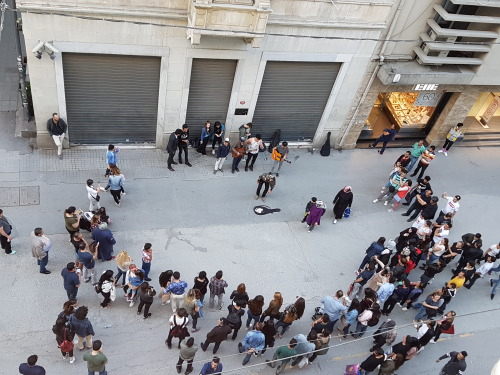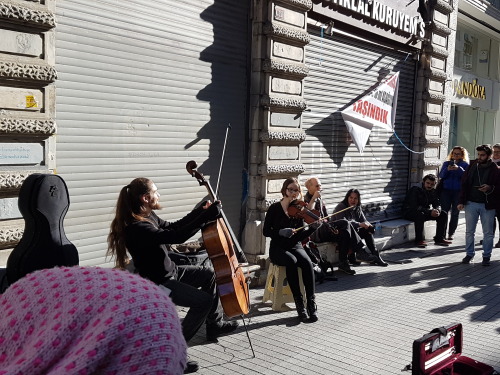
ANAMED Fellow Ivan Marić shares his impressions of the street musicians of Istiklal Avenue…
Istiklal Caddesi is a bustling heart of Beyoğlu connecting Taksim Square and Tünel. Even though vehicles regularly pass by, it is primarily a pedestrian zone of the highest traffic. Saying that Istiklal is quite noisy street is stating the obvious, but one understands it more fully after living next to it for a while and then finding oneself in a rare moment when the street is actually quiet (such as May 1st). Living in Merkez Han, one of the most disturbing noises are the constructions, until recently working from dusk till dawn on Istiklal and from dawn till dusk on Odakule, and every ANAMED resident’s favourite, Cafe De Vore across the street with Black Sea music almost every night. On a more positive end, although still a mixed bag, there are Istiklal street musicians.
They gather and perform between Şişhane metro station and Galatasaray Lisesi—in eight months, I can’t remember seeing any musician beyond this point, but I am not exactly sure why; it could be because of more numerous streets with vehicle traffic that cut Istiklal, or because there are very few places where musicians could station and not block an entrance to a shop or a restaurant. From the windows of the ANAMED fellows’ study room, one can see exactly this stretch of the street—the curve just before Galatasaray Lisesi to the right and almost up to Şişhane metro station to the left. This can occasionally be a blessing, or a curse (the clarinet guy!).

Caption: Street musicians playing Turkish popular music (view from ANAMED Fellows’ study room).
All musicians perform for gratuities of multitude of pedestrians who are their principle audience (ANAMED fellows are only a collateral). Accordingly, musicians’ repertoire can be relatively limited, long enough to keep the attention for ten minutes or so, but becoming repetitive if one stays longer, or works in a room above. While the repertoire might be limited individually, the choice of music at large is highly eclectic, depending on cultural background and preferences of performers and reflecting to a certain extent the varied composition and tastes of the passers-by to whom the musicians attempt to appeal.
Turkish traditional and popular music is best represented, followed closely with everyone’s favourite Black Sea music, which always includes at least one kemençe and often attracts part of the audience to dance in a circle. Fast-paced Arab music, usually performed by a larger band, is also quite popular—you can hear one of the more popular Arab street orchestras performing.

Passers-by joining the dance to the sounds of Black Sea music.
Apart from these groups of music, recognizable tunes from movies and TV shows are often played, like the iconic main themes from The Godfather, The Good, the Bad, and the Ugly, and Amélie, or, more contemporary, the opening track of Game of Thrones. Occasionally, one can also hear variety of internationally recognizable older pieces of diverse genres. Bella ciao is certainly high on the list, especially if performed on a variant of accordion or harmonica; ANAMED fellows can regularly hear an attempt at this tune by a small boy playing the melodica. Strangers in the Night, for some reason, is also very popular, not only on Istiklal, but around Istanbul. The Girl From Ipanema, Another Brick in the Wall, Polyushko Polye (popular Russian song), оr, more rarely, a well-known classical pieces like Brahms’ Hungarian Dance no 5, or even the Autumn Leaves, which became one of the jazz standards, can occasionally be heard too. There are also musicians and bands simply performing a nonspecific tune on an exotic instrument like the didgeridoo, usually wearing a picturesque costume. Relatively unique, there is also that short-bearded guy always dressed in a blue suite who sometimes hunts tourists down Istiklal pounding them with endless trills and shakes of his voice, but he is more often seen in the evening around restaurants, like Fıccın.

The boy playing Bella ciao on his melodica.

A String duo.

The didgeridoo.
Amidst this colorful myriad of musicians, one discrete performer caught my attention. She is usually positioned between Şişhane metro station and Dutch Consulate calmly playing her aqua drum—sometimes also called space or dream drum, which all seem as appropriate names. Tranquil sounds of the drum well matched with her unobtrusive disposition are in stark contrast with most of her colleagues and din and tumult of Istiklal in general. This sparked my curiosity. She speaks good English, so I was happy to get the chance to talk with her about the experience of being a street musician.
Katja is from Ukraine, where she used to have a more conventional job, “Before, I was an engineer in internet provider’s office. But I always dreamed about travelling and I got a solution :)” Aqua drum was her choice from the beginning, “I just watched YouTube videos, saw this and fell in love.” I was curious how come she came to Istanbul, and it turned out that the first thing to consider was a ‘technicality’—she does not need a visa for Turkey. She adds that she is much happier here than, for example, in Russia, where street musicians are banned apparently, “Policemen in Moscow sometimes take your instruments and chase you… not here, policemen give me money, and during the cold months they would bring me tea or coffee. Perhaps it’s because I’m a girl, I don’t know.” Climate in Istanbul suits her better too, particularly compared to her native country—“much warmer!” She is living near Tophane, so Istiklal is really neat for her. She also played at Kadiköy but prefers Istiklal, and emphasizes it is “not just because it is only five-minute walk from home :)” She notices there are fewer tourists lately, particularly from western countries. While she understands that the security situation is the main reason for it, she feels quite safe, “In my country there is a war… we had a revolution, so Istanbul is fine for me, or… business as usual.” Being the street musician is her main occupation, and she enjoys it, “I like my job, I like to play music and when I do it on the street I meet a lot of interesting people, I know more about mentality and culture of places where I play.” Once in a while, she also meets some of the many feline residents of Istanbul (for more on cats in Istanbul, check Laura Picht’s blog).

Katja (and a cat) playing the aqua drum.
Although Katja is happy in Istanbul, she plans to travel further. She was considering eastern Europe, places like Macedonia, Serbia, or Montenegro, for which she also doesn’t need a visa, but she actually prefers the Middle East—“it’s more exciting!” Her desire is to go to Lebanon or Israel during the summer, and she is already saving for the trip. I was happy to realize that even with a gentle approach, without quaint outfit or noisy performance, barely raising the eyes off the instrument, she receives the attention from Istiklal audience.
Some say that music is a ‘universal language of mankind,’ and it is certainly a universal feature of every culture; the exceptional diversity of musicians and music played on Istiklal Caddesi corresponds to the rich cultural diversity of the Beyoğlu district, and the city itself. Living and working in ANAMED, Istiklal street musicians are inseparable part of the experience, providing a ‘soundtrack to the study rooms and library’ (as noted by Elizabeth Murphy in her blog), and the ‘soundtrack’ is occasionally good. Even though not all musicians are necessarily enjoyable to listen for more than a few minutes, they are one of the trademarks of the street and it is hard to imagine that buzzing stretch of asphalt between Galatasaray Lisesi and Şişhane without them. Walking down the street on the Sunday after the Beşiktaş bombing in December 2016, something felt unusual and empty; then I realized there were no musicians playing.

Saturday night at Istiklal Caddesi.
I am thankful to Katja for patiently replying to my questions, and I wish her good luck and safe travels!

